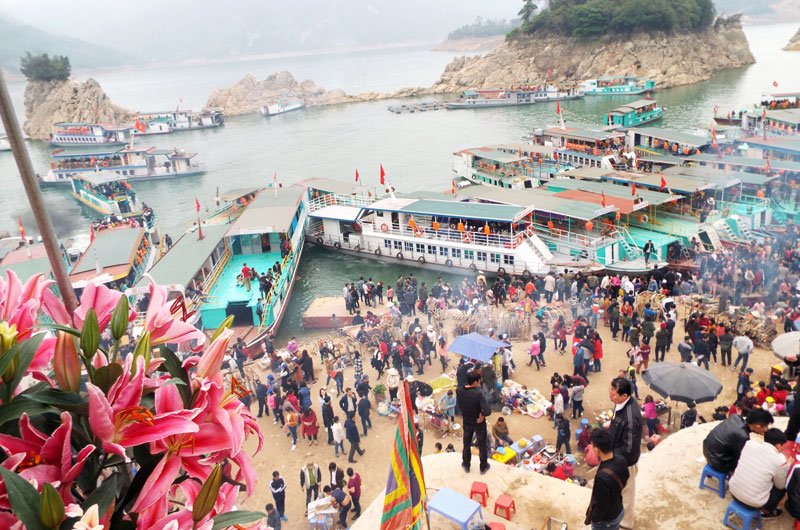
(HBO) – Bo Temple, or the Temple of Gods of Bo Waterfall, is a spiritual tourism destination that people cannot overlook when visiting Hoa Binh lake in the northern province of Hoa Binh. You can reach the temple by waterway after 30 minutes from Thung Nai wharf (Cao Phong district) or by passenger ships from Bich Ha wharf (Hoa Binh city), which takes one hour and a half.
Boarding a passenger ship, before reaching the Bo Temple, you
could enjoy the fresh air, contemplate the beauty of heaving mountains covered
with the lush green colour and feel the clear and cool water, as if you are in
the wonderland in Hoa Binh lake.

The
Bo Temple is a spiritual tourism site that attracts many visitors.
Previously, Bo Waterfall Temple was located in Hao Trang commune.
After many changes in administrative geography, the temple now lies in Thung
Nai commune, Cao Phong district and Vay Nua commune, Da Bac district.
Legend has it that the temple worships the Gods of Bo waterfall,
including Dinh Thi Van, a woman of the Muong ethnic group and another woman of
the Dao ethnic group in Vay Nua. Those women encouraged local people to donate
food and rowed along the waterfall together with people to support the army of
King Le Loi, helping them overcome the challenges of Da River. After many successful
trips, in their last voyage, the raging storm capsized the boat that was loaded
with a lot of food. Even after their passing, the soul of the two women still
helped people safely go through the waterfall and created favourable weather.
Thus, local residents honoured the women as the Gods and established a temple to
worship them.
Local people honour the two women as the "Gods of Bo waterfall”.
Each year, the Bo Temple’s festival begins on the second day of the Lunar New
Year and lasts until the fourth lunar month. The temple receives thousands of
visitors each day to pray for blessings. From the Bo Temple, people can see the
whole view of the immense lake and picturesque landscapes, bringing tranquil,
gentle and peaceful feelings, like all problems in life are put away.
During the trip to the Temple of Gods of Bo waterfall, visitors
can explore the Bo waterfall cavern, a gift of nature with mesmerising natural
structure created by thousand-year-old stalactites of various shapes./.
Gongs hold a special place in the cultural and spiritual life of the Muong ethnic people in Hoa Binh province. More than musical instruments, they are an indispensable part of community rituals and collective memory, echoing through generations as a spiritual thread linking the past, present, and future.
Preserving and promoting the cultural values of the Muong ethnic group has become an urgent task in the current context, as many traditional values face the risk of fading away. This effort requires not only protecting the cultural identity but also eliminating outdated customs and developing a modern cultural lifestyle, contributing to sustainable values for the Muong community in Hoa Binh province.
The Muong ethnic culture, deeply rooted in Vietnam’s mountainous north, continues to be preserved and revitalised by dedicated individuals and communities determined to safeguard their ancestral identity.
The Muong group is one of the largest ethnic minorities in Vietnam, primarily found in Hoa Binh province. The Muong people in Hoa Binh boast a rich and diverse cultural treasure that reflects the unique identity of this ethnic group. Accounting for over 63% of the province's population, they have created and preserved numerous distinctive cultural values, contributing to their unique identity. Their cultural heritage is an invaluable asset, at the heart of their national identity, and represents a vibrant spiritual life that must be preserved and promoted in today’s modern world.
For generations, the ethnic communities of Hoa Binh province, particularly the Muong people, have preserved vibrant festivals deeply intertwined with the region’s geography, nature, and social traditions. These celebrations enrich Hoa Binh’s spiritual life and cultural identity, reflecting both folk beliefs and the intermingling of ethnic customs. Many of these festivals have endured the test of time, passed down through generations and continuing to thrive today. Among them, the Khai Ha (Going Down to the Field) festival stands out as one of the most significant events of the Muong ethnic group.
Muong calendar, known as sach doi, is an ancient folk knowledge system developed through observations of the movement of the pleiades star. This unique calendar consists of 12 bamboo sticks, each representing a lunar month. Specific days within each month are marked with distinct symbols, guiding locals in determining auspicious and inauspicious days for important activities.



